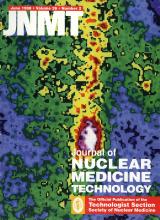Abstract
Objective: Both in vivo and in vitro red cell labeling methods are available for performing gastrointestinal bleeding studies. While in vitro labeling has been shown to result in higher binding efficiency, no comparison of clinical image quality has been reported between those techniques. This study compares in vivo and in vitro methods using both subjective and objective measurements of image quality.
Methods: A consecutive series of gastrointestinal bleeding studies performed on 23 patients using in vivo labeling was compared to a series of 23 studies using in vitro labeling. Images at 30 min postinjection were randomized and analyzed by two observers. Subjective evaluation of image quality, as well as renal activity, was based on a comparison of femoral vein and inferior vena cava activity to adjacent background using numerical scores with a scale of 0–3. Image quality using the subjective scores was further classified as acceptable and poor. Target-to-background measurements of femoral vein to adjacent soft tissue in the thigh and inferior vena cava to adjacent abdominal background also were made.
Results: In vitro label subjective image quality was acceptable in 87% and 91% of cases for vascular and renal activity, respectively, but only 35% and 52% for in vivo labeling. In vitro label target-to-background ratios were significantly better than in vivo label for the femoral vein and inferior vena cava, as well as for the subjective assessment of vascular image quality, but not for renal activity.
Conclusion: In vitro red cell labeling improves clinical image quality as compared with in vivo labeling. Both subjective and objective measurements of image quality are useful for comparing the results of labeling methods.







